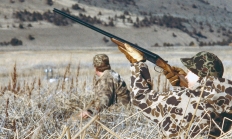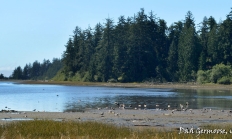Search myodfw.com
Showing 101 - 120 of 1507 results
Article
Rabbit hunting is the third most popular type of hunting activity in the U.S., behind wild turkey and deer hunting. Few people take advantage of it in Oregon, but they should—rabbits and hares are abundant and there is no closed season or bag limit. Plus, they taste good!

Article
Young animals are rarely orphaned, so leave them where you find them. Chances are good mom is nearby, just waiting for you to leave before she returns to her baby. Leaving young wildlife where they are is the right thing to do, picking it up and taking it home is illegal.

Article
Oregon offers some of the best upland game bird hunting in the West. The state’s diverse habitats support nine species of upland game birds— pheasants, chukar, Hungarian partridge, valley (California) quail, mountain quail, ruffed grouse, blue grouse, sage-grouse and wild turkey. There are upland hunting opportunities in every corner of the state, and one upland bird season or another is open continuously from September 1 through January 31. Throw in a six-week spring turkey season and you can hunt upland game birds in Oregon for more than half of the year! Also, since many of the species share similar habitat

Article
During summer drought and high temperatures, fish start feeling the heat. Give them a break by following these warm weather fishing guidelines.

Article
Oregon supports diverse waterfowl populations, from sea ducks in coastal saltwater to puddle ducks in the alkali basins of southeast Oregon. You might think you need lots of gear (decoys, boats, a trained dog) to hunt ducks and geese, but you don’t. All of these things are nice but not necessary. All you really need is a hunting license/tag, shotgun, shells and some basic identification skills.

Article
The number of big game hunters using blinds has increased over the last 20 years. Be sure to follow regulations if you plan to use them on federal land.

Article
A guide to the field identification of bull trout, brook trout, and their hybrids.

Article
This permit allows hunters with certain disabilities to use a draw locking device attached to the riser of a modern compound bow to help hold the bow at full draw.
September 1, 2021
Article
Just a few miles south of Newport, the town of Waldport is on the shores of Alsea Bay. It is one of Oregon’s estuaries that does not have jetties at the ocean entrance. Strong outgoing tides and ocean swell can make boating near the mouth of the bay more dangerous. Use caution and be prepared if you crab in this area.

Article
Wild steelhead mortalities are generally low under normal fishing regulations. But with several years of low runs , many anglers are wondering what extra steps they can take to avoid hooking a steelhead while they’re fishing.
May 26, 2022

Landing page
Find the 2020-21 weekly statistics for waterfowl and upland game birds at Klamath Wildlife Area.
September 15, 2017
Landing page
Find the 2020-21 weekly statistics for waterfowl and upland game birds at Klamath Wildlife Area.
September 15, 2017
Article
Coos Bay is Oregon’s largest bay. The lower bay (areas from the ocean entrance to the airport) is “marine dominated”, meaning there is little freshwater influence, and offers some of Oregon’s most productive shellfishing opportunities.

Landing page
Find the weekly statistics for waterfowl and upland game birds at Summer Lake Wildlife Area.
October 13, 2017
Article
Information gleaned from the teeth of harvested black-tail deer will help ODFW biologists learn more about the deer population.
Article
The areas around Bandon, on the Coquille River, have productive softshell beds. The areas near Bandon Marsh National Wildlife Refuge tend to be the most popular. Populations of other bay clams may be found close to the jettys but are mostly subtidal.

Landing page
Planning your 2020-21 Sauvie Island hunt? Check the weekly Hunt Reports (video), Eastside reservation summaries, and daily harvest summaries to see where the successful hunters have been shooting.
October 18, 2021
Article
Nehalem Bay offers both beach and boat access to softshell and purple varnish clam beds.

Article
Looking for the perfect gift for the hunter on your holiday list? We’ve asked some ODFW staff, all avid hunters, to share their gift-giving (and gift-getting) ideas.

Article
We asked some of the fisher folk at ODFW for their favorite gift-giving ideas. Here's what they said.

